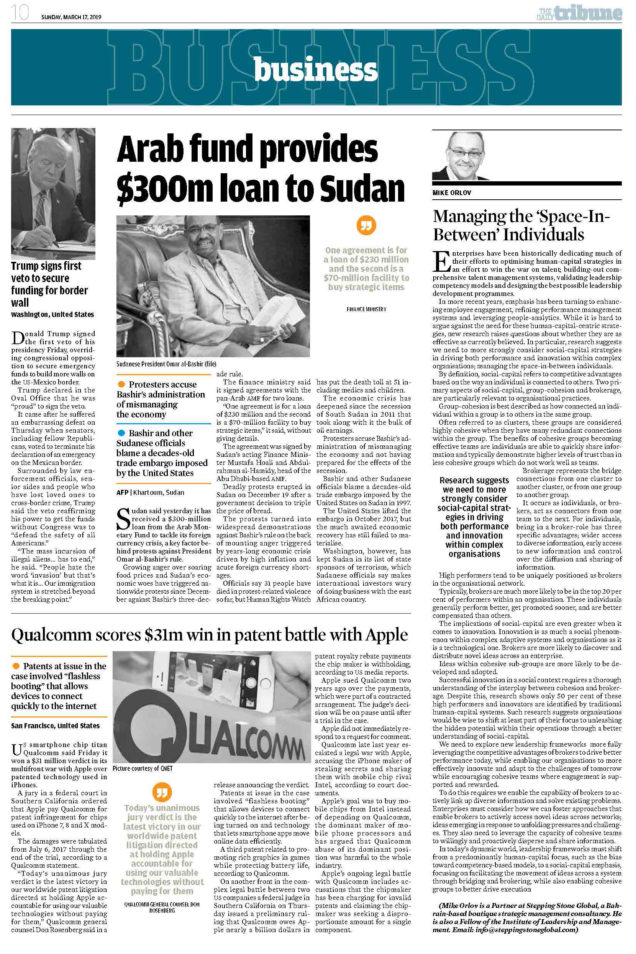Managing the ‘Space-In-Between’ Individuals
Enterprises have historically dedicated much of their efforts to optimising human-capital strategies in an effort to win the war on talent; building-out comprehensive talent-management systems, validating leadership-competency-models and designing the best possible leadership development-programmes.
In more recent years, emphasis has turned to enhancing employee engagement, refining performance management systems and leveraging people-analytics. While it is hard to argue against the need for these human-capital-centric strategies, new research raises questions about whether they are as effective as currently believed. In particular, research suggests we need to consider social-capital strategies in driving both performance and innovation within complex organisations; managing the space-in-between individuals.
By definition, social-capital refers to competitive advantages based on the way an individual is connected to others. Two primary aspects of social-capital, group-cohesion and brokerage between groups, are particularly relevant to organisational practices.
Group-cohesion is best described as how connected an individual is to others in the same group.
Often referred to as clusters, these groups are considered highly cohesive when they have many redundant connections within the group. The main benefit of cohesive groups becoming effective teams is individuals are able to quickly share information. Typically this leads to higher levels of trust than in less cohesive groups which do not work well as teams.
Brokerage between groups represents the connections from one cluster to another cluster, or from one group to another group; bridging between cohesive-teams
It occurs as individuals, or brokers, act as connectors from one team to the next. Individuals, in a broker-role have three specific advantages; wider access to diverse information, early access to new information and control over the diffusion and sharing of information.
High-performers and seial-achievers tend to be uniquely positioned as brokers in the organisational network.
Typically, brokers are much more likely to be in the top 20 per cent of performers within an organisation. These individuals are generally more productive, perform better, get promoted sooner, are more people-focused and are better compensated than others.
The implications of social-capital are even greater when it comes to innovation.
Innovation is as much a social phenomenon within complex adaptive systems and organisations as it is a technological phenomenon. Brokers are more likely to discover and distribute novel ideas across an enterprise.
Ideas within cohesive sub-groups are more likely to be developed and adopted if there is a broker involved in sharing with other teams.
Successful innovation in a social context requires a thorough understanding of the interplay between cohesion and brokerage. Despite this, research shows only 50 per cent of these high performers and innovators are identified by traditional human-capital systems. Such research suggests organisations would be wise to shift at least part of their focus to unleashing the hidden potential within their operations through a better understanding of social-capital.
We need to explore new leadership frameworks, more fully leveraging the competitive advantages of bonding in cohesive teams and brokering between teams, to drive performance, enabling our organisations to more effectively innovate and adapt to the challenges of tomorrow while continually encouraging our hard-won cohesive teams where engagement is supported and rewarded.
To do this requires enabling the capability of brokers to actively link-up diverse information and solve existing problems. Enterprises must consider how we can foster approaches which will enable brokers to actively access novel ideas across networks; ideas emerging in response to unfolding pressures and challenges. Enterprises also need to leverage the capacity of cohesive teams to willingly and proactively disperse and share information through recognized brokers.
In today’s dynamic world, leadership-frameworks must shift from a predominantly human-capital focus, such as the bias toward competency-based models, to a social-capital emphasis, focusing on facilitating the movement of ideas across a complex-adaptive-system through bridging and brokering, enabling cohesive teams to drive more effective productivity, performance and strategic-execution.

